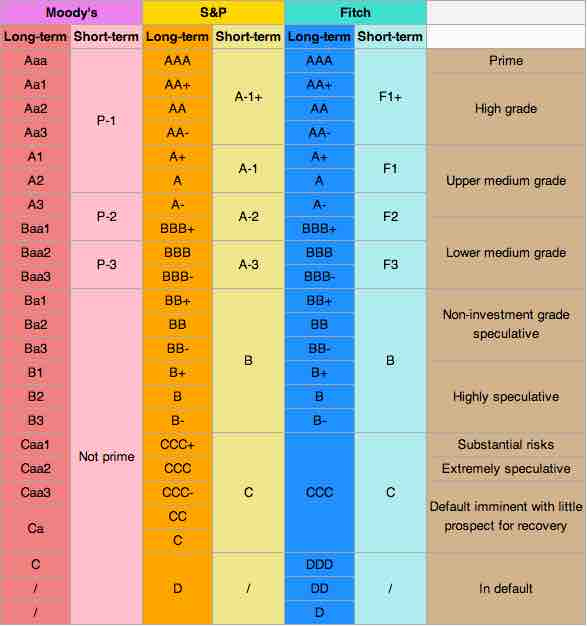Ratings Overview
In investment, the bond credit rating assesses the credit worthiness of a corporation's or government's debt issue. The credit rating is analogous to a credit rating for individuals. The "quality" of the issue refers to the probability that the bondholders will receive the amounts promised on the due dates.
The credit rating is a financial indicator to potential investors of debt securities, such as bonds. Ratings play a critical role in determining the amount that companies (and other entities that issue debt, including sovereign governments) have to pay to access credit markets; for example, the amount of interest that must be paid on issued debt. The ratings are assigned by credit rating agencies, such as Moody's, Standard & Poor's, and Fitch Ratings, and are given in letter designations (AAA, B, CC), which represent the quality of a bond. Generally they are bonds that are judged by the rating agency as likely enough to meet payment obligations; banks are thus allowed to invest in them. ""

Credit Rating Equivalents
Credit ratings are used to report on the credit worthiness of a bond issuing company or government
Investment-grade Bonds
A bond is considered investment-grade, or IG, if its credit rating is BBB- or higher by Standard & Poor's, or Baa3 or higher by Moody's, or BBB(low) or higher by DBRS.
Bond ratings below BBB/Baa are not considered to be investment-grade; these bonds are called junk bonds. Junk bonds are also called high-yield bonds. These are bonds that are rated below investment grade by the credit rating agencies. As these bonds are more risky than investment grade bonds, investors expect them to earn a higher yield. The threshold between investment-grade and speculative-grade ratings has important market implications for issuers' borrowing costs.
The risks associated with investment-grade bonds (or investment-grade corporate debt) are considered significantly higher than those associated with first-class government bonds. The difference between rates for first-class government bonds and investment-grade bonds is called "investment-grade spread. " The range of this spread is an indicator of the market's belief in the stability of the economy. The higher these investment-grade spreads (or risk premiums) are, the weaker the economy is considered.
Rating Agency Criticism
Until the early 1970s, bond credit ratings agencies were paid for their work by investors who wanted impartial information on the credit worthiness of securities issuers and their particular offerings. Starting in the early 1970s, the "Big Three" ratings agencies (S&P, Moody's, and Fitch) began to receive payment for their work by the securities issuers for whom they issued ratings, which led to current charges that these ratings agencies can no longer always be impartial when issuing ratings for securities issuers. Securities issuers have been accused of "shopping" for the best ratings from S&P, Moody's, and Fitch, in order to attract investors, until at least one of the agencies delivers favorable ratings.